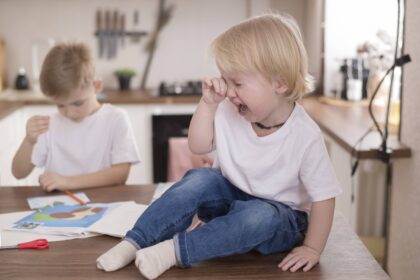It can be distressing for any parent or caregiver to see their child crying frequently. While crying is a normal and healthy way for children to express their emotions, excessive crying can sometimes be a sign of an underlying issue. As children grow and develop, their reasons for crying evolve and become more complex. Understanding the common causes of crying and learning effective strategies to soothe and support your child is essential for fostering their emotional well-being.
Common Reasons Why Children Cry
Children cry for a variety of reasons, and it's important to remember that crying is their primary way of communicating their needs and feelings, especially in the early years. Here are some of the most common reasons why children cry:
Physical Needs
Hunger, thirst, a wet or dirty diaper, feeling too hot or cold, or being tired can all trigger crying in children. Infants, in particular, rely on crying to communicate these basic needs. Imagine a baby who has just woken up from a nap. They might cry to signal that they are hungry and need to be fed.
Emotional Needs
Children may cry when they feel overwhelmed, stressed, scared, frustrated, angry, or sad. As they grow older, their emotional responses become more nuanced, and they may cry due to social situations, peer pressure, or academic challenges. For example, a toddler might cry when they are separated from their parent at daycare or when they struggle to build a block tower.
Pain or Discomfort
Crying can be a sign of pain or discomfort from an injury, illness, or medical condition. Ear infections, teething, stomachaches, and even hair tourniquets can cause significant distress in young children. A child who falls and scrapes their knee will likely cry due to the pain.
Overstimulation
Infants and young children can become easily overwhelmed by excessive noise, bright lights, or large crowds. This overstimulation can lead to crying as they struggle to process and cope with the sensory input. Think of a baby who becomes fussy and starts to cry after attending a birthday party with lots of people and loud music.
Need for Attention
Sometimes, children cry simply because they need attention and connection. They may not yet have the verbal skills to express this need directly, so they resort to crying to get your attention and reassurance. A young child might cry when their parent is busy on the phone and they want to play.
Colic
Colic is a term used to describe excessive crying in an otherwise healthy baby. It typically occurs in infants under 3 months of age and is characterized by crying that lasts for at least 3 hours a day, 3 days a week, for at least 3 weeks. While the exact cause of colic is unknown, it is thought to be related to digestive issues or an immature nervous system.
It's important to note that as children grow older, they tend to cry less. This is because they develop better language skills and are able to communicate their needs and feelings more effectively.
Identifying the Underlying Cause
Determining the reason for a child's crying can sometimes be challenging. Here are some strategies to help you identify the underlying cause:
Consider the Context
Pay attention to the circumstances surrounding the crying. What was your child doing before they started crying? Were they playing, eating, or interacting with others? If your child starts crying during a playdate, it could be due to a conflict with another child or frustration with a toy.
Observe Physical Cues
Look for any signs of physical discomfort, such as a fever, rash, or swelling. Check for a dirty diaper, and ensure your child is not too hot or cold. A child who is crying and pulling at their ear might have an ear infection.
Listen to the Cry
The pitch, intensity, and pattern of your child's cry can provide clues about the cause. A high-pitched cry may indicate pain, while a rhythmic cry might suggest hunger.
Consider Recent Events
Has your child experienced any changes in their routine, environment, or social interactions? Changes can be stressful for children and may trigger crying. Starting a new school or welcoming a new sibling can be significant adjustments for a child.
Rule Out Medical Conditions
If your child's crying is persistent, excessive, or accompanied by other symptoms like fever, lethargy, or changes in appetite, it's essential to consult a doctor to rule out any underlying medical conditions.
Observe Changes in Behavior
Along with crying, a child may not act normally when something is wrong. Pay attention to any changes in their behavior, such as increased sleep, loss of energy, changes in their cry, or refusal to eat. For example, if your child is usually active and playful but suddenly becomes withdrawn and cries more than usual, it could indicate an underlying issue.
Persistent Crying
Crying that persists after attempts to address routine needs and efforts to console should be investigated to identify a specific cause.
When to Seek Professional Help
While most crying is normal, there are times when it's important to seek professional help. Consider consulting a doctor or therapist if:
- Your child's crying is excessive, persistent, or interfering with their daily life.
- Your child's crying is accompanied by other concerning behaviors, such as aggression, withdrawal, or self-harm.
- You suspect your child may have an underlying medical or developmental condition.
- You feel overwhelmed or unsure about how to support your child's emotional needs.
Low Distress Tolerance
Some children have a lower tolerance for distress and may cry more easily or intensely than others. This can be due to various factors, including temperament, developmental stage, and past experiences. If your child seems to cry excessively over minor setbacks or frustrations, it might be helpful to seek professional guidance to help them develop coping skills and build resilience.
Taking Care of Yourself
It's important to remember that dealing with a crying child can be emotionally and physically draining for parents and caregivers. Don't hesitate to seek support from family, friends, or professionals if you're feeling overwhelmed. Taking care of your own well-being is crucial for being able to effectively care for your child.
Medical Reasons for Crying
While most crying is related to basic needs, emotions, or situational factors, there are some medical conditions that can cause excessive crying in infants and young children. Here's a table summarizing some of these conditions:
| Cause | Common Features | Tests |
|---|---|---|
| Heart disorders (e.g., heart failure, abnormal heart rhythm) | Difficulty breathing, difficulty feeding, excessive sweating, abnormal heart sound | Chest x-ray, ECG, echocardiography |
| Allergy to cow's milk protein | Vomiting, diarrhea or constipation, poor feeding, weight loss, blood in stools | Stool tests, endoscopy, colonoscopy |
| Constipation | Hard, infrequent bowel movements, pain during bowel movements, tears in the anus | Doctor's examination |
| Gastroesophageal reflux | Symptoms after feeding (fussiness, spitting up, arching of the back), cough when lying down, poor weight gain | Doctor's examination, upper digestive tract x-rays, pH probe or impedance probe, endoscopy |
| Incarcerated hernia | Red, swollen, tender bulge in the groin | Doctor's examination |
| Intussusception | Crying in bouts, drawing legs up to chest, abdominal tenderness, bloody stools | Ultrasonography, air enema |
| Volvulus | Vomiting, swollen abdomen, abdominal tenderness, blood in stools | Abdominal x-ray, barium or air enema |
| Ear infection | Cold symptoms (runny nose, cough), fever, ear pain | Doctor's examination |
| Meningitis | Fever, lethargy, bulging fontanelles, fussiness, irritability, poor feeding | Spinal tap |
| Urinary tract infections | Fever, crying or pain with urination | Urinalysis, urine culture |
| Broken bone | Swelling, bruising, unwillingness to use a limb, pain | X-rays |
| Corneal abrasion | No other symptoms | Fluorescein eye exam |
| Hair tourniquet | Swollen toe, finger, or penis with hair wrapped around it | Doctor's examination |
| Head injury | Inconsolable cry, swollen area on the head | Head CT scan |
| Testicular torsion | Swollen, painful, red scrotum | Doppler ultrasonography |
| Vaccine reaction | Recent vaccination | Doctor's examination |
It's important to remember that medical disorders are a less common cause of excessive crying. If you have concerns about your child's health, it's always best to consult a doctor.
Soothing a Crying Child
Once you've identified the potential cause of your child's crying, you can take steps to soothe and comfort them. Here are some effective soothing techniques:
Physical Comfort and Closeness
- Hold your child close: Physical touch and closeness can be very reassuring for a crying child. Try holding them in your arms, cuddling on the couch, or wearing them in a sling.
- Rock them gently: The rhythmic motion of rocking can be very calming for babies and young children. You can rock them in your arms, in a rocking chair, or even gently sway back and forth while holding them.
- Offer a pacifier: If your child uses a pacifier, offering it to them can provide comfort and a sense of security.
Movement and Sensory Stimulation
- Go for a walk or a ride: Taking your child for a walk in a stroller or a ride in the car can be a great way to soothe them. The change of scenery and the rhythmic motion can be distracting and calming.
- Try a warm bath: A warm bath can help relax your child and ease any physical tension. Add some bath toys or bubbles to make it more enjoyable.
- Give a baby massage: Gentle massage can be very soothing for babies. You can find baby massage courses at some health centers or clinics. Ask your midwife or health visitor for information.
Sound and Distraction
- Sing or hum: Soft singing or humming can be very calming for a crying child. Choose lullabies or familiar songs that your child enjoys.
- Play calming music: Playing soft, instrumental music can create a soothing atmosphere and help your child relax.
- Use white noise: Some children find white noise, like the sound of a vacuum cleaner, fan, or running water, to be soothing.
- Distract with a toy or book: Try engaging your child with a toy, book, or simple game. Sometimes, a change of scenery or activity can help shift their focus away from what's upsetting them.
For Babies 2 Months and Younger
- Swaddling: Swaddling can be a very effective way to soothe newborns and young babies. It provides a sense of security and warmth, similar to the feeling of being held. However, it's important to stop swaddling when your baby shows signs of being able to roll over, as it can become a safety hazard.
Remember to be patient and try different techniques to see what works best for your child. Sometimes, a combination of approaches is needed to soothe a crying child.
Helping Your Child Cope with Emotions
As children grow, it's important to help them develop healthy ways to cope with their emotions. Here are some strategies to support your child's emotional development:
Acknowledge and Validate
Let your child know that it's okay to feel their emotions, even the negative ones. Help them label their feelings and validate their experiences. For example, you could say, “I see that you're feeling frustrated because you can't find your favorite toy. It's okay to feel frustrated.”
Teach Coping Skills
Introduce your child to different coping mechanisms, such as deep breathing exercises, counting to calm down, or taking a break. You can practice these skills together when your child is calm, so they are better prepared to use them when they're upset.
Create a Calm-Down Kit
Put together a box with items that help your child relax and regulate their emotions, such as coloring books, stress balls, or calming music. Encourage your child to use the calm-down kit whenever they feel overwhelmed or need a break.
Model Emotional Regulation
Show your child how you manage your own emotions. When you're feeling stressed or frustrated, verbalize your feelings and demonstrate healthy coping strategies. For instance, you might say, “I'm feeling a little stressed right now, so I'm going to take a few deep breaths to help me calm down.”
Problem-Solve Together
If your child is upset about a specific problem, help them brainstorm solutions and work through challenges. For example, if they're upset because they don't want to share a toy, you could help them come up with alternative solutions, such as taking turns or finding a different toy to play with.
Recognize and Name Emotions
One of the first steps in helping children manage their emotions is teaching them to recognize and name their feelings. Encourage your child to identify and label their emotions, such as “happy,” “sad,” “angry,” or “scared.” This self-awareness can help them understand and regulate their feelings more effectively.
Use Stories to Explore Emotions
Books, shows, and movies can be valuable tools for helping children understand and process emotions. While reading or watching together, pause to ask questions like, “How do you think that character is feeling?” or “What could they do to feel better?” This can help your child develop empathy and learn different ways to respond to emotions.
Wraping It Up
Crying is a natural part of childhood, and it's essential to approach your child's tears with empathy and understanding. By identifying the underlying causes, providing comfort and support, and teaching healthy coping skills, you can help your child navigate their emotions and develop emotional resilience.
Remember that different soothing techniques and coping strategies may be more effective depending on the reason for your child's crying. If your child is crying due to overstimulation, creating a calming environment with reduced noise and distractions can be particularly helpful. If they are crying because of frustration, helping them problem-solve or offering a distraction might be more effective.
As a parent, it's important to trust your instincts and seek support when needed. If you have concerns about your child's crying or emotional well-being, don't hesitate to reach out to your pediatrician, a child psychologist, or other trusted professionals. With patience, understanding, and the right support, you can help your child navigate the challenges of growing up and develop into a happy and emotionally healthy individual.











